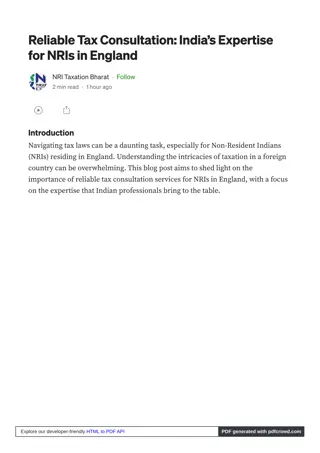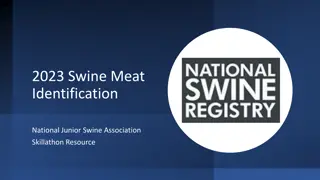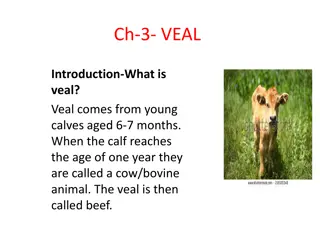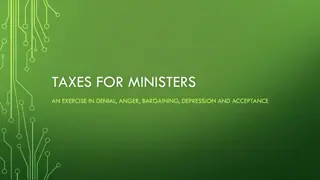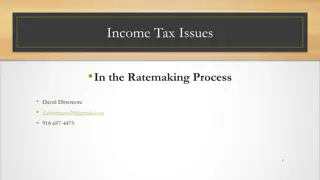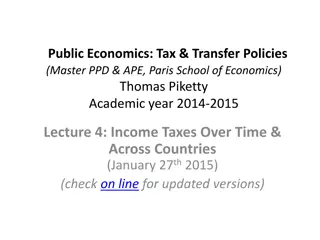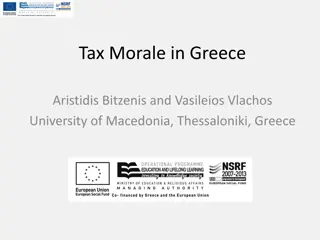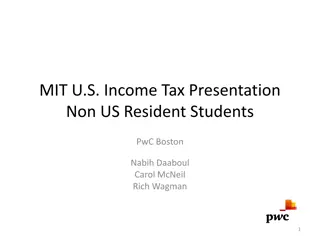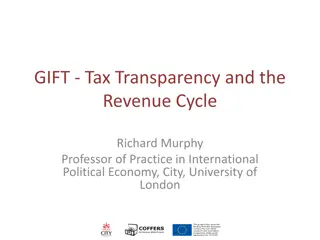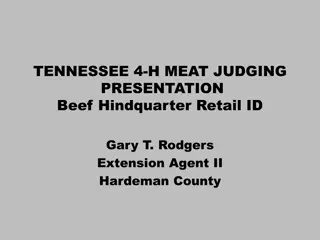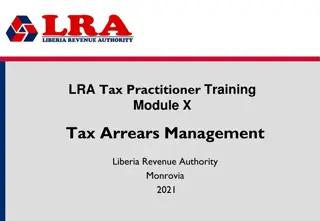Effects of Tax Cuts on Organizational Form Choices
This paper assesses the effects of the Tax Cuts and Jobs Act on organizational form choices. It provides historical context, analyzes changes in business operations, and evaluates the impact on firms' behavior.
Download Presentation

Please find below an Image/Link to download the presentation.
The content on the website is provided AS IS for your information and personal use only. It may not be sold, licensed, or shared on other websites without obtaining consent from the author.If you encounter any issues during the download, it is possible that the publisher has removed the file from their server.
You are allowed to download the files provided on this website for personal or commercial use, subject to the condition that they are used lawfully. All files are the property of their respective owners.
The content on the website is provided AS IS for your information and personal use only. It may not be sold, licensed, or shared on other websites without obtaining consent from the author.
E N D
Presentation Transcript
Tax Policy and Organizational Form: Tax Policy and Organizational Form: Assessing the Effects of the Tax Cuts Assessing the Effects of the Tax Cuts and Jobs Act and Jobs Act Erin Henry* University of Memphis George A. Plesko* Steven Utke University of Connecticut *Henry and Plesko hold positions as economists with the Statistics of Income Division of the Internal Revenue Service. The views expressed in this paper are solely those of the authors and do not represent those of the U.S. Department of Treasury or the Internal Revenue Service.
Research Agenda Research Agenda Provide historical context to assess implications Analyze organizational form choices after TRA86 Estimate magnitude of changing incentives of TCJA Model effect of TCJA on organizational form choices Evaluate anecdotal evidence Summarize practitioner guidance and initial behavioral responses of firms
Historical Context: Tax Reform Historical Context: Tax Reform Act of 1986 Act of 1986 Maximum corporate tax rate: 34% + earnings taxed at individual level when distributed Maximum individual tax rate: 28% Incentive to convert to pass-through form Empirical evidence suggests business owners responded to the incentive. Plesko (1994), Plesko (1995a,b), Ayers et al. (1996), Omer et al. (2000)
Historical Context: Tax Reform Historical Context: Tax Reform Act of 1986 Act of 1986 How did business operations change in response to the change in organizational form? Economic magnitude of business operations Compensation mix Payout policy Related-party financing decisions
Historical Context: Tax Reform Historical Context: Tax Reform Act of 1986 Act of 1986 Number of firms by Corporate Status Pre- and Post TRA86 Pre-TRA 86 C Corporation C Corporation S Corporation S Corporation Post-TRA 86 C Corporation S Corporation S Corporation C Corporation Weighted N 400,045 70,613 129,945 3,897 C to S Conversions by Year Post TRA86 Weighted N 33,388 21,865 17,593 6,080 78,926 70% of C to S Conversions 1987 1988 1989 1990 Total
Historical Context: Tax Reform Historical Context: Tax Reform Act of 1986 Act of 1986 Figure 3 Positive and Negative TNI: Change from 1984 Base 2.50 2.00 1.50 1.00 0.50 0.00 1984 1985 1986 CtoC neg_tni 1987 1988 1989 1990 CtoC pos_tni CtoS pos_tni CtoS neg_tni
Historical Context: Tax Reform Historical Context: Tax Reform Act of 1986 Act of 1986
Historical Context: Tax Reform Historical Context: Tax Reform Act of 1986 Act of 1986 Figure 6 Loans from Stockholders: Change from 1984 Base 1.20 1.00 0.80 0.60 0.40 0.20 0.00 1984 1985 1986 1987 1988 1989 1990 CtoS CtoC
Modelling the Effect of TCJA on Modelling the Effect of TCJA on Organizational Form Choice Organizational Form Choice Simple model of organizational form choice: (1- P) > (1- C)(1- E) After-tax return of passthrough entity After-tax return of corporate entity Post TRA 86 72% 48% Post TCJA 63% 63.2%
Modelling the Effect of TCJA on Modelling the Effect of TCJA on Organizational Form Choice Organizational Form Choice Our model includes the effects of varying tax rates on methods of distributions to shareholder- employees: Salary self-employment tax rate Dividends/Retained Earnings preferential rates
Modelling the Effect of TCJA on Modelling the Effect of TCJA on Organizational Form Choice Organizational Form Choice We use our model to compare after-tax rates of return for: C corporations, S corporations, Partnerships Across low ($250,000) and high ($750,000) income scenarios And various distribution scenarios 0%, 50%, and 100% distributions Distributions comprised of 0%/100%, 50%/50%, and 100%/0% salary/dividend mix
Modelling the Effect of TCJA on Modelling the Effect of TCJA on Organizational Form Choice Organizational Form Choice Low Income High Income SERVICE High Income - MFG
Modelling the Effect of TCJA on Modelling the Effect of TCJA on Organizational Form Choice Organizational Form Choice Low Income High Income SERVICE High Income - MFG
Modelling the Effect of TCJA on Modelling the Effect of TCJA on Organizational Form Choice Organizational Form Choice Low Income High Income SERVICE High Income - MFG
Modelling the Effect of TCJA on Modelling the Effect of TCJA on Organizational Form Choice Organizational Form Choice Low Income High Income SERVICE High Income - MFG
Modelling the Effect of TCJA on Modelling the Effect of TCJA on Organizational Form Choice Organizational Form Choice Low Income High Income SERVICE High Income - MFG
Modelling the Effect of TCJA on Modelling the Effect of TCJA on Organizational Form Choice Organizational Form Choice Low Income High Income SERVICE High Income - MFG
Anecdotal Evidence Anecdotal Evidence Be patient (in contrast to response to TRA86) Uncertainty with respect to bill s longevity and interpretation of its provisions Many individual-specific circumstances are important in the decision (KPMG, BDO) Non-tax costs may become important (in contrast to response to TRA86) Ares Management LP and KKR & Co LP conversions
Summary and Conclusions Summary and Conclusions Response to TRA86 was swift in terms of organizational form and business decisions. Response to TCJA will be slower and net effect will likely be smaller. THANK YOU!
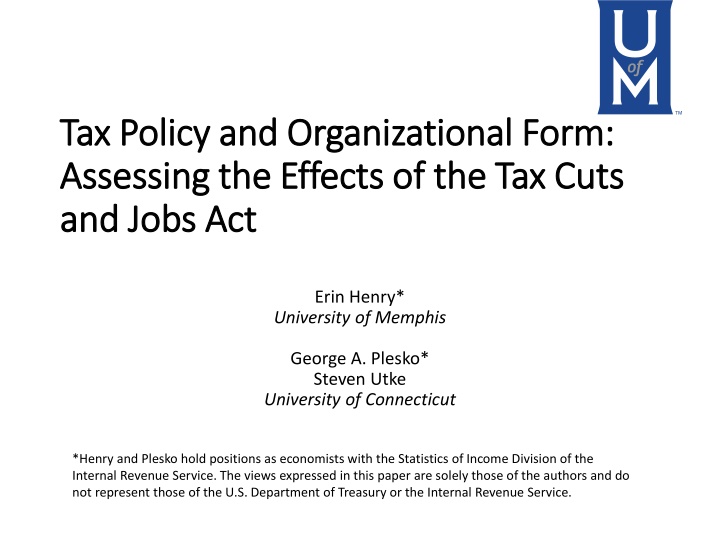


![Town of [Town Name] Real Estate Tax Rates and FY 2024 Budget Summary](/thumb/62211/town-of-town-name-real-estate-tax-rates-and-fy-2024-budget-summary.jpg)
